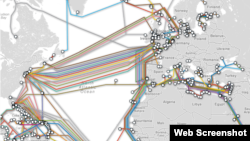It seems like something more fitting of a Cold War-era James Bond movie script than present-day reality: unnamed Pentagon officials circulating reports that Russian naval vessels and submarines are lurking around undersea cables that link the United States to Europe and Asia.
The unnamed officials speculate the Russians might be trying to tap those links — or even worse, completely sever them during a time of crisis.
That’s exactly what unnamed U.S. military and intelligence officials have been telling influential news outlets such as The New York Times.
They’re not alone. Last week, retired NATO Supreme Commander Admiral John Stavridis warned that undersea fiber-optic cables handle almost all the world’s Internet communications and represent a serious security vulnerability should an adversary attack them.
This week, a bipartisan group of U.S. senators requested information from the secretaries of state, defense and homeland security regarding the safety of nearly 200 fiber-optic cables that link the globe electronically.
"Due to increased Russian aggression and their presence in waters these cables rest in, we are increasingly concerned with what a targeted attack on the cables the U.S. depends on could result in," the senators said in their request.
Cables cut all the time
"Nearly all the world’s Internet traffic passes at some point through an underwater cable," said Doug Madory, director of Internet research at the cyber-intelligence firm Dyn. "And rarely a week goes by that there isn’t a submarine cable break somewhere in the world."
According to the firm TeleGeography, approximately 200 active submarine cables crisscross the ocean’s floors. These cables electronically link all of the world’s continents, except Antarctica, and nearly every island with a human population.
Undersea cables are generally around a mere 3 inches in diameter and composed of various layers of insulation, steel cables and water protection. Deep inside are bundles of thin optical fibers — tiny, flexible fibers marginally larger than a human hair. Each can each carry huge amounts of digital data; together they handle over 95 percent of all Internet and phone data between continents.
Some nations, such as Cuba or New Zealand, have only one main cable connecting them to the global Internet.
"For countries relying on a single submarine cable, the loss of that cable could be crippling for their Internet service," Madory told VOA. "They may be able to fall back on bulk satellite service, but satellite has much greater latency and less capacity."
The U.S., by contrast, has several dozen cables connected to its Atlantic and Pacific coast hubs.
Shark snack
Exposed along the vast expanses of ocean seafloor, these cables face a wide range of hazards, including dragging anchors and, in some areas, sharks that inexplicably like chewing on the cables' polyethylene sheathing.
"When close to shore, these cables are encased in protective metal shielding and buried up to 3 meters deep in the seabed, but out in the deep sea they are unprotected and as thin as a garden hose," said Madory. "If someone was able to locate these cables at sea, they could easily cut them."
So could one nation sabotage another by simply mapping those cables and tapping into them — or, worse, cutting them?
"The U.S. and the former Soviet Union repeatedly tapped each other’s land lines during the Cold War," noted Christopher Harmer, senior naval analyst with the Institute for the Study of War and retired deputy director with the U.S. Navy’s Fifth Fleet.
"The U.S. Navy tapped the Russian Pacific Fleet data lines for at least a couple of years," said Harmer.
Harmer and Madory agreed that in most areas, undersea cables could easily be cut and that the Russians have a few vessels capable of deep sea maneuvers.
Harmer said the Pentagon has long been aware of the cables' vulnerabilities to potential threats.
"Transoceanic cables are high-value targets that are extremely vulnerable to attack," Harmer told VOA via email. "The U.S. Navy is highly aware of the threat, has simulated the scenarios, understands the risks, but does not have the assets to mitigate the risks.”
Cutting vs. tapping
However, Madory downplays the size of the problem for the U.S.
"There are multiple cables crossing the Atlantic and Pacific, providing enormous capacity and resilience for the Internet in North America," Madory wrote via email. "To even make a dent in U.S. international connectivity would require simultaneously taking out multiple cables.
"If a perpetrator with a submarine wanted to cause maximal downtime, they could attempt to cause multiple breaks at harder-to-reach locations on multiple cables, but the impacts would be fleeting," said Madory. "So would such a Hollywood scenario be worth trying to pull off?"
"I don't think the Russians have a significant advantage here," said Harmer. "Their economy has devolved into a resource extraction economy; they need customers for it. Cutting data lines also cuts off their customers in Western Europe from communication with North America. The real threat is IT [Internet technology] theft by China or Russia."
Madory disagrees. "Experts in the industry are very doubtful that it is possible to tap a fiber-optic cable on the seabed without it being noticed," he said.
Perhaps not, said Harmer. But that doesn’t mean that someone isn't trying.








